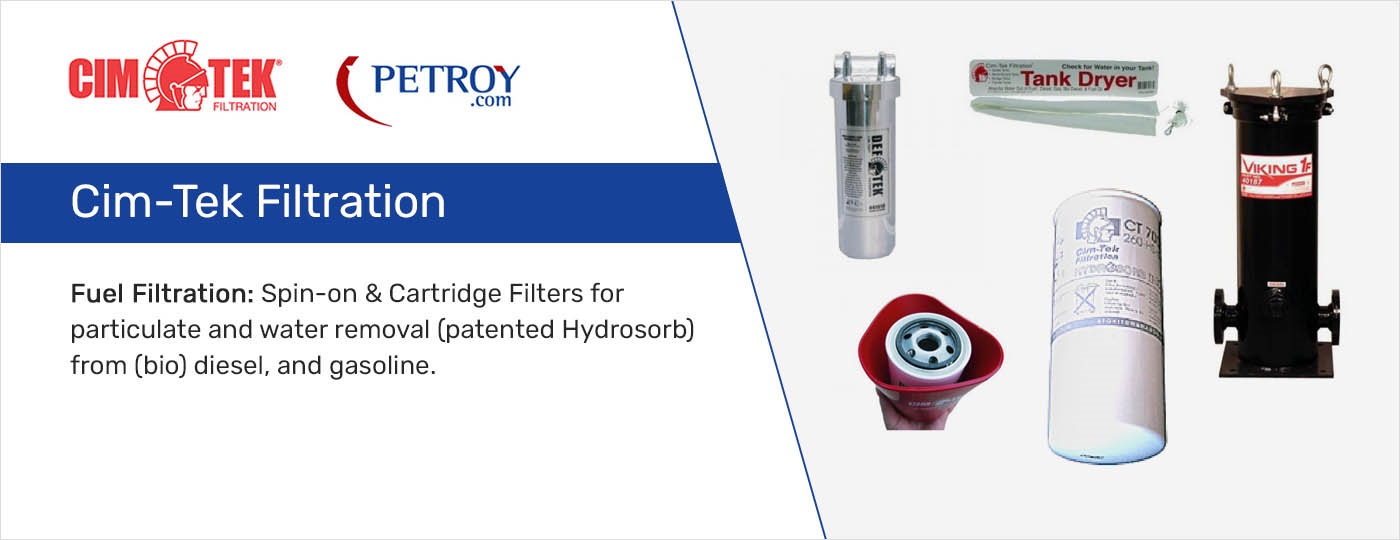

Cim-Tek Filtration
Fuel Filtration: Spin-on & Cartridge Filters for particulate and water removal (patented Hydrosorb) for (bio) diesel, and gasoline.
Why should you use Cim-Tek HydroSorb Filters?
There are many reasons why transport companies, fleet owners and farmers should use Cim-Tek HydroSorb Filters on their dispensing equipment.
Still there are many of them taking the risk of getting dirt and most importantly / damaging, water inside the tank of their privately owned vehicles.
The only insurance to prevent damage to the engines of their vehicles is by using a HydroSorb / Bio-Tek Filter on the pump at their fuel storage tank.
HydroSorb is our patented technology for particulate and water removal from fuels.
HydroSorb is a fiberglass medium impregnated with a super-absorbent (for water) that is laminated to a resin-impregnated cellulose filter paper. During filtration, water is absorbed from hydrocarbons (fuel) preventing contaminated fuel, which gradually causes a saturation of the filter media, resulting in reduction in flow rate (an indication that the filter has worked well and now needs to be replaced).
Water Holding Capacities
Gravity Filter & Adaptor
We discontinued the adaptor that belonged to the CT70066, so we only sell this Filter as a replacement for the ones who are in the market.
Do you know why there is a difference between the flow rates on the Filter and on our website?
The flow rates on the filters are reached in the laboratory (under perfect conditions, using industrial fluid) and according to USA standards, the flow rates in the www.petroy.com site are observed in the field (actual application) to prevent slowing down the flow soon after (due to saturation) the filter installation.
When do you change from the regular HydroSorb Filters to Bio-Tek Filters?
The Bio-Tek filters work exactly the same as our normal filters for diesel, except that they are made of materials that are resistant to the aggressive effects of bio-fuels (bio-diesel and/or alcohols).
We advise that if the Bio content goes over 7%, you better change to the Bio-Tek filters.
Make your engine smile!
The moment the winter is arriving in Europe and with it the problems with starting the engines. Hydrosorb filters offer protection against bad quality fuel and worcolork all year long to guarantee quality fuel, on demand, continuously. As the filter retains a little bit of water every time the tank of a vehicle is filled up we stand a chance of having it blocked (by freezing) in extremely cold conditions. Therefore we advise to change the filter just before the winter. Since the filter must be changed at least once a year anyway, it makes sense to change it before the winter.
Factors Affecting the Contamination of Clean Fuel in Storage Tanks
The following points can all contribute to the contamination of good clean fuel supplied into bulk storage tanks. Fuel contamination by water and dirt can lead to loss of efficiency, engine malfunctions and premature clogging of vehicle filter systems.
RATE OF USAGE
The longer the fuel spends sitting in the tank the more likely it is to build up contamination through condensation & microbiological growth.
ABOVE OR BELOW GROUND TANKS
Condensation builds up when the tank breathes, i.e lets air in & out as fuel is used, replenished, and as the fuel shrinks & expands with temperature. The temperature of the fuel in a below ground tank is more constant throughout the year and so should breathe less. Therefore above ground tanks are more susceptible to condensation build up.
LOCATION OF TANK
An above ground tank sited in the sun will breathe more than a tank sited in a more sheltered location and therefore will be more prone to condensation build up.
AGE OF THE TANK
The longer the tank has been in use the greater the build up of internal site and scale. Although this usually collects out of harms way at the bottom of the tank, deliveries to the tank stir up the sediment and over the years the depth of silt can start to reach the outlet level.
FREQUENCY OF CLEANING
Obviously the more often the tank is cleaned out the less risk of contamination. However, even regular annual cleaning cannot prevent a rapid build up of contamination.
TANK MAINTENANCE
If the tank is not properly maintained it is likely to corrode, adding further to contamination levels.
WEATHER TIGHTNESS OF TANKS
The better the weatherproofing the less the chance of rainwater seepage into the tank. An offset fill pipe is much better than a direct manlid fill, but leaky vents, tank gauges and pipe joints can all let water in.
QUALITY OF FUEL PURCHASED
The fuel you dispense to your vehicles can only be as good as the fuel you buy. This can be easily controlled by buying from a reputable source. With all these various factors contributing to the potential contamination of your fuel it makes sense to protect your vehicles. Don’t wait until you find a problem. It might be too late! .......... You don’t wait until you have an accident before you take out insurance.
